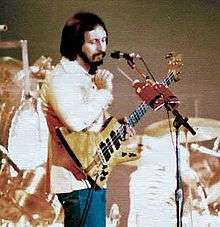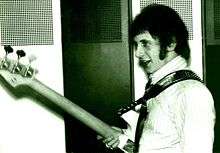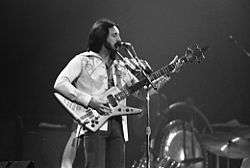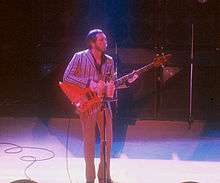John Entwistle
| John Entwistle | |
|---|---|
 Entwistle in 1976 | |
| Background information | |
| Birth name | John Alec Entwistle |
| Also known as | The Ox, Thunderfingers, The Quiet One, Big Johnny Twinkle |
| Born |
9 October 1944 Chiswick, Greater London, England, UK |
| Died |
27 June 2002 (aged 57) Paradise, Nevada, US |
| Genres | |
| Occupation(s) |
|
| Instruments |
|
| Years active | 1961–2002 |
| Labels | |
| Associated acts |
|
| Notable instruments | |
| |
John Alec Entwistle (9 October 1944 – 27 June 2002) was an English singer, songwriter, composer, musician, film and music producer. In a music career that spanned more than 40 years, Entwistle was best known as the original bass guitarist for the English rock band The Who. He was the only member of the band to have formal musical training.[1][2] He was inducted into the Rock and Roll Hall of Fame as a member of the Who in 1990.
Entwistle's instrumental approach used pentatonic lead lines, and a then-unusual treble-rich sound ("full treble, full volume") created by roundwound RotoSound steel bass strings. He was nicknamed "The Ox" and "Thunderfingers," the latter because his digits became a blur across the four-string fretboard.[3] In 2011, he was voted as the greatest bass guitarist of all time in a Rolling Stone Magazine reader's poll.[4] According to The Biography Channel, Entwistle is considered by many to be the best rock bass guitarist that ever lived, and is considered to have done for the bass what Jimi Hendrix did for the guitar.[5]
Early life
John Alec Entwistle was born on 9 October 1944 in Chiswick, a suburb of London.[6] He was an only child. His father, Herbert, played the trumpet[7] and his mother, Maud (29 November 1922 – 4 March 2011), played the piano.[8] His parents' marriage failed soon after he was born, and he was mostly raised by his mother at his grandparents' house in South Acton.[9] Divorce was uncommon in the 1940s, and this contributed to Entwistle becoming reserved and socialising little.[8]
His musical career began aged 7, when he started taking piano lessons. He did not enjoy the experience and after joining Acton County Grammar School aged 11, switched to the trumpet,[8] moving to the French horn when he joined the Middlesex School's Symphony Orchestra.[9] He met Pete Townshend in the second year of school, and the two formed a trad jazz band, the Confederates. The group only played one gig together, before they decided that rock 'n' roll was a more attractive prospect.[7] Entwistle, in particular, was having difficulty hearing his trumpet with bands, and decided to switch to playing guitar, but due to his large fingers, and also his fondness for the low guitar tones of Duane Eddy, he decided to take up the bass guitar instead.[10] He made his own instrument at home, and soon attracted the attention of Roger Daltrey, who had been the year above Entwistle at Acton County, but had since left to work in sheet metal. Daltrey was aware of Entwistle from school, and asked him to join as a bass guitarist for his band, the Detours.[11]
Early career
After joining the Detours, Entwistle played a major role in encouraging Pete Townshend's budding talent on the guitar, and insisting that Townshend be admitted into the band as well. Eventually, Roger Daltrey fired all the members of his band with the exception of Entwistle, Townshend and the drummer, Doug Sandom, a semi-pro player who was several years older than the others. Roger Daltrey relinquished the role of guitarist to Pete Townshend in 1963, instead becoming frontman and lead singer. The band considered several changes of name, and finally settling on the name the Who while Entwistle was still working as a tax clerk (temporarily performing as the High Numbers for four months in 1964).[12] When the band decided that the blond Roger Daltrey needed to stand out more from the others, Entwistle dyed his naturally light brown hair black, and it remained so until the early 1980s.
Around 1963, Entwistle played in a London band called the Initials for a short while; the band broke-up when a planned resident engagement in Spain fell through.
In 1967, Entwistle married his childhood sweetheart Alison Wise and bought a large semi-detached home in Stanmore Middlesex filling it with all sorts of extraordinary artefacts, ranging from suits of armour to a tarantula spider. His eccentricity and taste for the bizarre was to remain with him throughout his life, and when he finally moved out of the city in 1978, to Stow-on-the-Wold in Gloucestershire, his 17-bedroom mansion, Quarwood, resembled a museum. It also housed one of the largest guitar collections belonging to any rock musician.[3]
Entwistle picked up two nicknames during his career as a musician. He was nicknamed "The Ox" because of his strong constitution and seeming ability to "Eat, drink or do more than the rest of them." He was also later nicknamed "Thunderfingers". Bill Wyman, bass guitarist for the Rolling Stones, described him as "the quietest man in private but the loudest man on stage". Entwistle was one of the first to make use of Marshall stacks in an attempt to hear himself over the noise of his band members, who famously leapt and moved about on the stage, with Pete Townshend and Keith Moon smashing their instruments on numerous occasions (Moon even used explosives in his drum kit during one memorable television performance on the "Smother Brothers Comedy Hour"). Townshend later remarked that Entwistle started using Marshall amplification to hear himself over drummer Keith Moon's rapid-fire drumming style, and Townshend himself also had to use them just to be heard over Entwistle. They both continued expanding and experimenting with their rigs, until they were both using twin stacks with new experimental prototype 200 watt amps, at a time when most bands used 50–100 watt amplifiers with single cabinets. All of this quickly gained the Who a reputation for being "the loudest band on the planet", a point well proven when they famously reached 126 decibels at a 1976 concert in London, listed in the Guinness Book of World Records as the loudest rock concert in history. The band had a strong influence at the time on their contemporaries' choice of equipment, with Cream and the Jimi Hendrix Experience both following suit. Although they pioneered and directly contributed to the development of the "classic" Marshall sound (at this point their equipment was being built/tweaked to their personal specifications), they only used Marshall equipment for a couple of years. Entwistle eventually switched to using a Sound City rig, with Pete Townshend following suit later as well. Townshend points out that Jimi Hendrix, their new label mate, was influenced beyond just the band's volume. Both Entwistle and Townshend had begun experimenting with feedback from the amplifiers in the mid-1960s, and Hendrix did not begin destroying his instruments until after he had witnessed The Who's "auto-destructive art".

Entwistle's wry and sometimes dark sense of humour clashed at times with Pete Townshend's more introspective, intellectual work. Although he wrote songs on every Who album except for Quadrophenia, he was frustrated at Townshend not allowing him to sing them himself. As he said, "I got a couple [of songs] on per album but my problem was that I wanted to sing the songs and not let Roger sing them."[13] This was a large part of the reason that he became the first member of the band to release a solo album, Smash Your Head Against the Wall (1971) which featured contributions from Keith Moon, Jerry Shirley, Vivian Stanshall, Neil Innes and the Who's roadie, Dave "Cyrano" Langston.
He was the only member of the band to have had formal musical training. In addition to the bass guitar, he contributed backing vocals and performed on the French horn (heard on "Pictures of Lily"), trumpet, bugle, and jaw harp, and on some occasions he sang the lead vocals on his compositions. He layered several horns to create the brass section as heard on songs such as "5:15", among others, while recording the Who's studio albums, and for concerts, arranged a horn section to perform with the band.

While Entwistle was known for being the quietest member of the Who, he in fact often exerted major influences on the rest of the band. For instance, Entwistle was the first member of the band to wear a Union Jack waistcoat. This piece of clothing later became one of Pete Townshend's signature garments.[14]
Entwistle designed the cover art for the band's 1975 album The Who by Numbers and in a 1996 interview remarked that it had cost £30 to create while the Quadrophenia cover, designed by Pete Townshend, had cost £16,000.
Entwistle also experimented throughout his career with "Bi-amping," where the high and low ends of the bass sound are sent through separate signal paths, allowing for more control over the output. At one point his rig became so loaded down with speaker cabinets and processing gear that it was dubbed "Little Manhattan," in reference to the towering, skyscraper-like stacks, racks and blinking lights.
Solo career
In 1971, Entwistle became the first member to release a solo album, Smash Your Head Against the Wall, which earned him a cult following in the US for fans of his brand of black humour. Other solo studio albums included: Whistle Rymes (1972), Rigor Mortis Sets In (1973), Mad Dog (1975), Too Late the Hero (1981), and The Rock (1996). In 1974, he compiled Odds & Sods, a collection of unreleased Who material. The band was preoccupied with recording The Who by Numbers during the spring of 1975 and did not do any touring for most of the year, so Entwistle spent the summer performing solo concerts. He also fronted the John Entwistle Band on US club tours during the 1990s, and appeared with Ringo Starr's All Starr Band in 1995. A talented artist, Entwistle held regular exhibitions of his paintings, with many of them featuring the Who.[3]
Late career
In 1990, Entwistle toured with The Best, a short-lived supergroup which included Keith Emerson, Joe Walsh, Jeff "Skunk" Baxter, and Simon Phillips. Towards the end of his career, he formed the John Entwistle Project with longtime friend, drummer Steve Luongo, and guitarist Mark Hitt, both formerly of Rat Race Choir. This evolved into "The John Entwistle Band", with Godfrey Townsend replacing Mark Hitt on guitar and joining harmony vocals. In 1996, the band went on the "Left for Dead" tour with Alan St. Jon joining on keyboards. After Entwistle toured with the Who for Quadrophenia in 1996–97, the John Entwistle Band set off on the "Left for Dead – the Sequel" tour in late 1998, now with Gordon Cotten on keyboards. After this second venture, the band released an album of highlights from the tour, titled Left for Live and a studio album Music from Van-Pires in 2000. The album featured lost demos of Who drummer Keith Moon together with newly recorded parts by the band.[15] In 1995, Entwistle also toured and recorded with Ringo Starr in one of the incarnations of Starr's All-Starr Band. This one also featured Billy Preston, Randy Bachman, and Mark Farner. In this ensemble, he played and sang "Boris the Spider" as his Who showpiece, along with "My Wife". Toward the end of his career he used a Status Graphite Buzzard Bass, which he had designed. From 1999 to early 2002, he played as part of the Who. Entwistle also played at Woodstock '99, being the only performer there to have taken the stage at the original Woodstock. As a side project, he played the bass guitar in a country-rock album project of original songs called the Pioneers, with Mickey Wynne on lead guitar, Ron Magness on rhythm guitar and keyboards, Roy Michaels, Andre Beeka on vocals, and John Delgado playing drums. The album was released on Voiceprint. Shortly before his death, Entwistle had agreed to play some US dates with the band including Nashville's Grand Ole Opry, following his final upcoming tour with The Who.
In 2001, he played in Alan Parsons' Beatles tribute show A Walk Down Abbey Road. The show also featured Ann Wilson of Heart, Todd Rundgren, David Pack of Ambrosia, Godfrey Townsend, Steve Luongo, and John Beck. That year he also played with the Who at The Concert for New York City. He also joined forces again with the John Entwistle Band for an 8-gig tour. This time Chris Clark played keyboards. From January–February, 2002, Entwistle played his last concerts with the Who in a handful of dates in England, the last being on 8 February at London's Royal Albert Hall. In late 2002, an expanded 2-CD Left for Live Deluxe was released, highlighting the John Entwistle Band's performances.
Death
Entwistle died in Room 658 at the Hard Rock Hotel and Casino in Las Vegas, Nevada, on 27 June 2002, one day before the scheduled first show of the Who's 2002 United States tour. He had gone to bed that night with a stripper/groupie, Alycen Rowse, who woke at 10 a.m. to find Entwistle cold and unresponsive. The Clark County medical examiner determined that his death was due to a heart attack induced by a cocaine overdose.[16] His funeral was held at St Edward's Church in Stow-on-the-Wold, Gloucestershire, England, on 10 July 2002. He was cremated and his ashes were buried privately. A memorial service was held on 24 October at St. Martin-in-the-Fields, Trafalgar Square, London. Entwistle's huge collection of guitars and basses were auctioned at Sotheby's in London by his son, Christopher, to meet anticipated taxes on his father's estate.
On Pete Townshend's website, Townshend and Roger Daltrey published a tribute, saying, "The Ox has left the building — we've lost another great friend. Thanks for your support and love. Pete and Roger."[12]
Entwistle's mansion in Stow-on-the-Wold in the Cotswolds and some of his personal effects were later sold off to meet the demands of the Inland Revenue; coincidentally, he had worked for the agency from 1962-1963 as a tax officer before being demoted to filing clerk, prior to joining The Who.
One aspect of Entwistle's life emerged after his death that came as a surprise even to those closest to him, including the members of the Who. "It wasn't until the day of his funeral that I discovered that he'd spent most of his life as a Freemason," said Pete Townshend.[17]
Welsh-born bass guitarist Pino Palladino, who had previously played on several of Townshend's solo albums, took over for Entwistle onstage when the Who resumed their postponed U.S. tour on 1 July 2002.[18] Pete Townshend and Roger Daltrey spoke at length about their reaction to Entwistle's death. Some of their comments can be found on The Who Live in Boston DVD.
On the opening night of their Vapor Trails tour, which began in Hartford, Connecticut on 28 June 2002 (the night after Entwistle's death), Geddy Lee of Rush dedicated the band's performance of the song "Between Sun and Moon" to Entwistle.[19]
Oasis played a version of "My Generation" during their set at T in the Park on Saturday 13 July 2002 as a tribute to Entwistle.
Technique

Entwistle's playing technique incorporated fingerstyle, plectrum, tapping, and the use of harmonics. He changed his style between songs and even during songs to alter the sound he produced. His fingering technique involved plucking strings very forcefully to produce a trebly, twangy sound. He changed his thumb position from pick-up to the E string and occasionally even positioning his thumb near the pick-up. His plectrum technique involved holding the plectrum between his thumb and forefinger, with the rest of his fingers outstretched for balance.
The Who's studio recordings seldom did justice to Entwistle's playing, in part because he was better heard in concert, where he and Pete Townshend frequently exchanged roles, with Entwistle providing rapid melodic lines and Townshend anchoring the song with rhythmic chord work. At the same time, Townshend noted that Entwistle provided the true rhythmic timekeeping in the band, while Keith Moon, with his flourishes around the kit, was more like a keyboard player. In 1989, Entwistle pointed out that, by modern standards, "the Who haven't got a proper bass player."[20]
Entwistle also developed what he called a "typewriter" approach to playing the bass. It involved positioning his right hand over the strings so all four fingers could be used to tap percussively on the strings, causing them to strike the fretboard with a distinctive twangy sound. This gave him the ability to play three or four strings at once, or to use several fingers on a single string. It allowed him to create passages that were both percussive and melodic. This method should not be confused with tapping or slapping, and in fact predates these techniques. Modern players such as Ryan Martinie of Mudvayne have used similar techniques. Entwistle can be seen using this technique in Mike Gordon's film, Rising Low. Notable in his left-hand technique was his use of slides, positioning his left hand for octaves, and his use of the pentatonic when playing with the Who.
Entwistle was notorious for the extremely high volume at which he played bass, going so far as to rig pick-ups to each string on his instruments. This led to him developing hearing loss, similar to Townshend. Although not as public about his problems as Townshend, he reputedly had to rely on lip reading to understand speech in his later years. Randy Bachman of Bachman-Turner Overdrive claimed that towards the end of his life, Entwistle mostly played by feeling the rush of air from his giant amp stacks.[21]
Songwriting
While Townshend emerged as the Who's songwriter-in-chief, Entwistle began making distinctive contributions to the band's catalogue, beginning with "Whiskey Man" and "Boris the Spider" on the A Quick One album in 1966, continuing with "Doctor, Doctor" and "Someone's Coming" (1967); "Silas Stingy" from The Who Sell Out (1967); "Dr. Jekyll & Mr. Hyde" (1968); and "Heaven And Hell", with which the Who opened their formidable live shows between 1968 and 1970. Entwistle wrote "Cousin Kevin" and "Fiddle About" for the Who's 1969 album Tommy because Pete Townshend had specifically requested Entwistle to write 'nasty songs' that he felt uncomfortable with. "My Wife", Entwistle's driving, comedic song about marital strife from 1971's Who's Next, also became a popular stage number. He wrote "Success Story" for The Who by Numbers (1975), for which he also drew the illustration on the album cover; "Had Enough", "905", and "Trick of the Light" for Who Are You (1978); "The Quiet One" and "You" for Face Dances (1981); and "It's Your Turn", "Dangerous" and "One at a Time" for It's Hard (1982), his final album with the Who.[3]
Artistic background
Between 1996 and 2002, Entwistle attended dozens of art openings in his honour. Always gracious, he took the time to chat with each collector, personalising their art with a quote and a sketch of "Boris". In early 2002, Entwistle finished what was his last drawing. "Eyes Wide Shut" represented a new style for Entwistle. Featuring Jimi Hendrix, Pete Townshend, Jimmy Page and Eric Clapton, John Entwistle's style had evolved from simple line drawings and caricatures to a more lifelike representation of his subjects. He was more confident and relaxed with his art and ready to share that with his collectors.[3]
Entwistle wrote this on one of his pictures:
"Now...! I'm still the Bass Guitarist. If you're reading this Bio at a show – don't forget to wave – I'm the one on the left. If you're reading this at an Art Show – Help support a starving Artist BUY SOMETHING!"[3]
Influence
Entwistle identified his influences as a combination of his school training on French horn, trumpet, and piano (giving his fingers strength and dexterity). Musicians who influenced him included rock & roll guitarists Duane Eddy and Gene Vincent, and American soul and R&B bass guitarists such as James Jamerson. In turn, Entwistle has been a considerable influence on the playing styles and sounds used by generations of bass guitarists that have followed him, including Geezer Butler,[22] Steve Harris, Matt Freeman, Krist Novoselic, Cliff Burton, Ian Hill, Geddy Lee,[23] Billy Sheehan,[24] Victor Wooten,[25] Tom Petersson,[26] Sam Rivers, John Myung,[27] and Chris Squire.[28] Entwistle continues to top 'best ever bass player' polls in musicians magazines. In 2000, Guitar magazine named him "Bassist of the Millennium" in a readers' poll.[29] J. D. Considine ranked Entwistle No. 9 on his list of "Top 50 Bass Players".[30] He was named the second best rock bassist on Creem Magazine's 1974 Reader Poll Results.[31] In 2011, a Rolling Stone Magazine reader poll selected him as the No. 1 rock bass guitarist of all time.[4]
Equipment
Entwistle collaborated with bass guitar manufacturers such as Alembic and Warwick.[32][33]
Discography
Studio albums
- Smash Your Head Against the Wall (1971)
- Whistle Rymes (1972)
- Rigor Mortis Sets In (1973)
- Mad Dog (1975)
- Too Late the Hero (1981)
- The Rock (1996)
- Music from Van Pires (2000)
References
- ↑ "24 X 7". Infoplease.com. 2002-06-27. Retrieved 2014-07-04.
- ↑ Archived 4 July 2015 at the Wayback Machine.
- 1 2 3 4 5 6 Archived 3 July 2015 at the Wayback Machine.
- 1 2 Archived 11 April 2012 at the Wayback Machine.
- ↑ "BIOGRAPHY: John Entwistle Lifetime". Thebiographychannel.co.uk. Archived from the original on 2 November 2013. Retrieved 2014-07-04.
- ↑ Marsh 1983, p. 24.
- 1 2 Marsh 1983, p. 26.
- 1 2 3 Marsh 1983, p. 25.
- 1 2 Neill & Kent 2009, p. 12.
- ↑ Marsh 1983, p. 29.
- ↑ Marsh 1983, p. 30,32.
- 1 2 "Entertainment | The Who bassist Entwistle dies". BBC News. 2002-06-28. Retrieved 2014-07-04.
- ↑
- ↑ [Eliscu, Jenny. "Rock & Roll: John Entwistle - The Who Bassist Dies at Fifty-Seven on the Eve of a Major U.S. Tour". www.proquest.com. Rolling Stone LLC. Retrieved 30 September 2014.]
- ↑ "Music from Van-Pires - The John Entwistle Band - Songs, Reviews, Credits". AllMusic.
- ↑ Martin Hickman, Stripper found John Entwistle dead after a Heart Attack triggered by cocaine, The Independent, 12 December 2002, Accessed 6 February 2009.
- ↑ Caesar Caruana (10 November 2011). "Quadrophenia was nearly "the end", says Pete Townshend". MusicRadar.com. Retrieved 2 January 2012.
- ↑ Archived 19 March 2012 at the Wayback Machine.
- ↑ "Headbangers - Rush Live in Hartford, CT". Knac.Com. 15 July 2002. Archived from the original on 1 August 2014. Retrieved 2014-07-04.
- ↑ Guitar Player's Chris Jisi in 1989
- ↑ Randy Bachman's Vinyl Tap Stories, pp 45
- ↑ Jason Ankeny (1949-07-17). "Geezer Butler | Biography". AllMusic. Retrieved 2014-07-04.
- ↑ "Geddy Lee | Biography". AllMusic. 1953-07-29. Retrieved 2014-07-04.
- ↑ Greg Prato (1953-03-19). "Billy Sheehan | Biography". AllMusic. Retrieved 2014-07-04.
- ↑ Heather Phares. "Victor Wooten | Biography". AllMusic. Retrieved 2014-07-04.
- ↑ Doug Stone (1950-05-09). "Tom Petersson | Biography". AllMusic. Retrieved 2014-07-04.
- ↑ "Interview - John Myung - For Bass Players Only". For Bass Players Only. 31 March 2014.
- ↑ Soocher, Stan: "Squire's bass fire", Circus Weekly, 13 March 1979, 33.
- ↑ Archived 8 March 2012 at the Wayback Machine.
- ↑ "Rocklist.net...Steve Parker...New Boo Of Rock Lists". Rocklistmusic.co.uk. 1980-10-04. Retrieved 2014-07-04.
- ↑ "Rocklist.net...Creem magazine selected readers". Rocklistmusic.co.uk. Retrieved 2014-07-04.
- ↑ Entwistle, John. Bass Culture: The John Entwistle Guitar Collection. Sanctuary, London 2004, ISBN 978-1860745935.
- ↑ Wetzel, Michael (11 September 2013). "Video: German Warwick Bass Guitars". Deutsche Welle TV. Retrieved 18 April 2015.
- Books
External links
| Wikimedia Commons has media related to John Entwistle. |
- The Who Concert Guide: John Entwistle Tour Archive
- The John Entwistle Foundation
- The Who's Marshall history
- John's gear reference